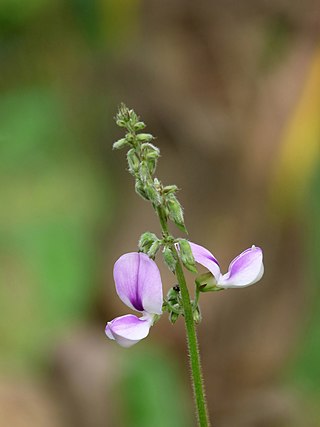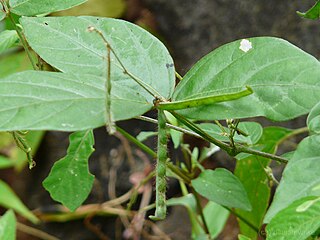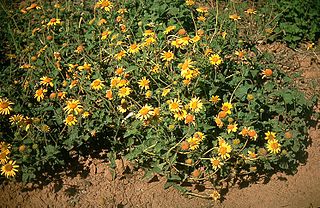
Lonicera morrowii, the Morrow's honeysuckle, is a deciduous honeysuckle in the family Caprifoliaceae, native to Japan, Korea, and Northeast China. It is a shrub, reaching a height of 2–2.5 m, with oblong leaves 4–6 cm long. It leafs out quite early in the spring, and in North America is commonly the first deciduous shrub with foliage in March. The flowers are white to pale yellow, and the fruit is a dark red berry 7–8 mm diameter containing numerous seeds. The berries, while eaten frequently by birds, are considered poisonous to humans. It is colloquially called "bush honeysuckle" in the United States, and is considered an invasive species.

Acorus is a genus of monocot flowering plants. This genus was once placed within the family Araceae (aroids), but more recent classifications place it in its own family Acoraceae and order Acorales, of which it is the sole genus of the oldest surviving line of monocots. Some older studies indicated that it was placed in a lineage, that also includes aroids (Araceae), Tofieldiaceae, and several families of aquatic monocots. However, modern phylogenetic studies demonstrate that Acorus is sister to all other monocots. Common names include calamus and sweet flag.

Hamamelidaceae, commonly referred to as the witch-hazel family, is a family of flowering plants in the order Saxifragales. The clade consists of shrubs and small trees positioned within the woody clade of the core Saxifragales. An earlier system, the Cronquist system, recognized Hamamelidaceae in the Hamamelidales order.

Pueraria is a genus of 15–20 species of legumes native to south, east, and southeast Asia and to New Guinea and northern Australia. The best known member is kudzu, also called Japanese arrowroot. The genus is named after 19th century Swiss botanist Marc Nicolas Puerari.

The Papaveraceae are an economically important family of about 42 genera and approximately 775 known species of flowering plants in the order Ranunculales, informally known as the poppy family. The family is cosmopolitan, occurring in temperate and subtropical climates, but almost unknown in the tropics. Most are herbaceous plants, but a few are shrubs and small trees. The family currently includes two groups that have been considered to be separate families: Fumariaceae and Pteridophyllaceae.

The Heliantheae are the third-largest tribe in the sunflower family (Asteraceae). With some 190 genera and nearly 2500 recognized species, only the tribes Senecioneae and Astereae are larger. The name is derived from the genus Helianthus, which is Greek for sun flower. Most genera and species are found in North America and South America. A few genera are pantropical.

Agastache is a genus of aromatic flowering herbaceous perennial plants in the family Lamiaceae. It contains 22 species, mainly native to North America, one species native to eastern Asia. The common names of the species are a variety of fairly ambiguous and confusing "hyssops" and "mints"; as a whole the genus is known as giant hyssops or hummingbird mints.

Lycopus is a genus of herbaceous plants in the family Lamiaceae. The many species are known as water horehound, gypsywort, and bugleweed and are native to Europe, Asia, Australia, and North America. The species are most often found in wetlands, damp meadows, and stream banks. Some of the wetland species have become endangered.

Platycarya is a genus of flowering plants in the family Juglandaceae native to eastern Asia in China, Korea, and Japan.

Chelone is a genus of four species of perennial herbaceous plants native to eastern North America. They all have similarly shaped flowers, which vary in color from white to red, purple or pink. Chelone cuthbertii, C. glabra, and C. lyonii are diploid and C. obliqua is either tetraploid or hexaploid, depending on their slight differences in morphology and localities.

Amphicarpaea bracteata is an annual to perennial vine in the legume family, native to woodland, thickets, and moist slopes in eastern North America.

Sigesbeckia is a genus of annual plants in the family Asteraceae. St. Paul's wort is a common name for some of the species. Sigesbeckia is widely distributed and has been traditionally used for the management of chronic diseases, including arthritis.

Stenanthium is a North American genus of flowering plants in the tribe Melanthieae of the family Melanthiaceae.
Pseudeminia is a genus of flowering plants in the legume family, Fabaceae. It belongs to the subfamily Faboideae. It includes four species of herbs or subshrubs native to southern and central tropical Africa, mostly in the Zambezian region. Typical habitats include seasonally-dry tropical woodland, thicket, bushland, wooded grassland, and scrubland, and in former cultivated areas.

Strophostyles is monophyletic three-species genus of flowering plants in the family Fabaceae, subfamily Faboideae. Common names for the genus include wild bean and fuzzybean. It consists of annual and perennial herbaceous vines, ranging in their native distribution from Nevada, east to Florida, and north to the Great Lakes and eastern Canada. The etymology of the name is strophe (turning) + stylos (style), referring to the curve of the style within the keel petal.

Teramnus is a genus of flowering plants in the legume family, Fabaceae. It includes eight species of climbing herbs and subshrubs native to the tropics of the Americas, sub-Saharan Africa, the Arabian Peninsula, the Indian Subcontinent, Indochina, Hainan, Taiwan, and New Guinea. Typical habitats are seasonally-dry tropical bushland and thicket, grassland, wooded grassland, and forest clearings, often in open and dry rocky areas.

Simsia is a genus of flowering plants in the tribe Heliantheae within the family Asteraceae. It includes annuals, herbaceous perennials, and shrubs. They range from the western United States south through Central and South America to Argentina, with the center of diversity occurring in Mexico. The genus is named for British physician and botanist John Sims (1749–1831). Although some species are relatively rare, others have become common weeds that line the roadsides and fields of Mexico, often forming dense stands mixed with Tithonia and other Asteraceae. Some species are known by the common name bushsunflower.

Carex bigelowii is a species of sedge known by the common names Bigelow's sedge, Gwanmo sedge, and stiff sedge. It has an Arctic–alpine distribution in Eurasia and North America, and grows up to 50 centimetres (20 in) tall in a variety of habitats.

Eucommia is a genus of small trees now native to China, with a fossil record that shows a much wider distribution. The single living species, Eucommia ulmoides, is near threatened in the wild, but is widely cultivated in China for its bark, and is highly valued in herbology such as traditional Chinese medicine.

Phyllodoce caerulea, known as blue heath in British English and purple mountain heather or blue mountainheath in American English, is an evergreen species of dwarf shrub that grows up to around 15 cm (6 in) tall, and bears clusters of 2–6 purple flowers. It is native to boreal regions around the Northern Hemisphere, but with large gaps in its distribution.


















